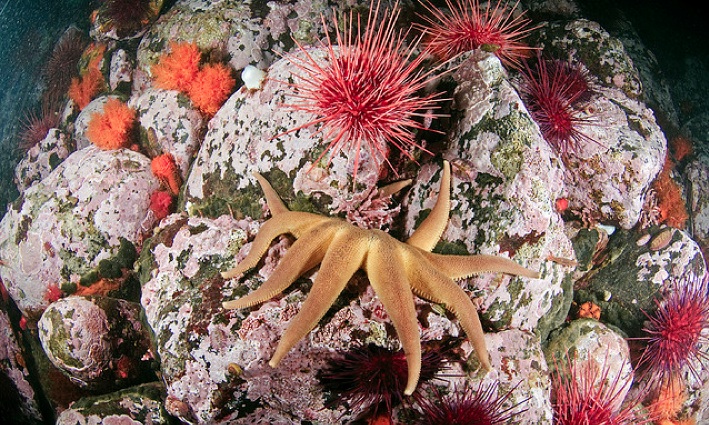Description
Solaster dawsoni, named after its finder is an eight to sixteen armed starfish. Ranging from grey, yellow, brown or red with light patches covering the upper surface of its body, this sea star looks very much like a “sun”. It can grow up to a radius of 25cm (10″) with the central disk in between the arms a third of its total radius. It has radial symmetry and an endoskeleton like most other starfish and again, uses the normal water vascular system. It moves around on tube feet and therefore is a very slow moving animal. It breaths through skin gills.
Habitat
Solaster dawsoni resides in the cold, rocky intertidal and subtidal costal waters of the west coast of America, ranging from Alaska right down to California. It lives on a variety of bottom types, and can survive from the low tide line to around 420 metres (1200 feet) deep.
Feeding
Solaster dawsoni, unlike other species, preys on other sea stars. It is the “feared” predator of the orange cucumber and other starfish have been known to flee when touched by it. It will even prey on its own kind including its very close relative Solaster stimpsoni. This sea star also eats sea cucumbers and diamondback nudibranchs. Solaster dawsoni has to either overlap or grasp its prey before it can secure it and because of its slowness this may be the only way it can catch its prey. Because of sea stars’ “blindness”, a large sea star will sometimes flee when touched by a small one. In this way, Solaster dawsoni has been known to kill larger sea stars than itself.
ReproductionThe sun star spawns in the period of March to June when the ovaries contain the full sized oocytes (eggs). It releases large yolky eggs which float to the surface, where they are fertilized and develop into pelagic non-feeding larvae which are also buoyant. At this stage the larvae can not feed but can swim around. From here they then develop into sea stars.Defences and PredatorsAs the most fearsome of all the starfish, Solaster dawsoni is almost completely safe in the water. As mentioned already, one of this sea stars only predators is in fact, its own species.Biotic interactionSolaster dawsoni is a very passive organism. Living on its own, the only interactions it has are with its prey. Also during reproduction, the male and female are much closer together.
|
||||||||||||||||||||||


